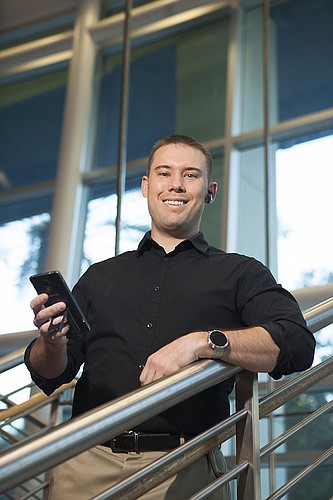- November 23, 2024
-
-
Loading

Loading

John Toner has been an inventor since he was 10 years old, keeping a book full of inventions. In college, he started a company that provided 3-D animations and an Android application for trial attorneys. In the past few years, he taught himself 3-D printing and built a virtual reality game, remaking the ice castle from “Frozen” for his niece.
The 31-year-old is now navigating the world of bringing an invention to market, and it hasn't been easy. In addition to his day job in the rapid prototyping division at American Express in St. Petersburg, Toner is dedicating six hours a day to his invention company, SynergyWiz. “It's a labor of love. It's what I enjoy doing,” he says.
For more than a decade, one of Toner's biggest frustrations was charging cell phone headsets separately. He also wasn't impressed by the lack of innovation in the mobile industry during the past few years.
That's why he invented StandN, a charging station and kickstand that carries and charges your Bluetooth headset for your smartphone. Toner is negotiating with a couple of large Bluetooth companies that have expressed interest in the product, but he hasn't finalized a deal. He talked to the Business Observer to share some of his tips he's learned in the process.
LinkedIn is your friend. Toner puts in a lot of time researching on LinkedIn to learn more about the companies he thinks may be interested in licensing. He also uses the social network to make contacts.
Research people who are product development specialists at the companies that might be interested in your product, he suggests. Then, find that person's boss, ideally someone at the VP level, he says.
Don't be afraid to pick up the phone and share your pitch. Once Toner has the name, location and contact information (found via Google), he calls the VP-level person. And it seems to work. He gets a 20% callback rate on this outreach.
“When you first call, do not get sent to legal or purchasing,” he says. “Go to marketing, brand or sales.
“When you introduce yourself to the company, tell them you are a product developer, not an inventor. Being an inventor sounds a little out there, but every large company has a product development department.”
Have a one-page document or website for more product information. Focus on the benefit to the end consumer. Add the company logo to your marketing material when you pitch the idea. Make it so little is left to the imagination, Toner advises.
Buy a 3-D printer. Toner used a 3-D printer to “weed out the ideas that are good in theory but not in practice.”
He made 300 versions of StandN before getting to the model where he is today. “It's not so much I designed it as it's evolved.”
The idea is similar to agile software development. The product doesn't have to be perfect to pitch it. This could lead to feedback on changes you need to make from your discussions with companies.
File a provisional patent before going public with the idea. A provisional patent protects the idea for one year. If you don't file, and talk about it publicly, it could be “considered public domain,” Toner says.
Before the year is up, you have to file for a full patent, which ranges from $8,000 to $12,000, depending on attorneys' fees. Toner advises not to start with this level of patent, because most likely your product will change after your discussions with companies.
Don't give up. Rejections can help your product evolve or pivot, according to Toner.
After a rejection, “ask for advice on what could better fit their needs,” he says. Also ask if you can call back with future ideas. Don't give up right away.“You should call at least 30 companies before reassessing your idea,” he says.